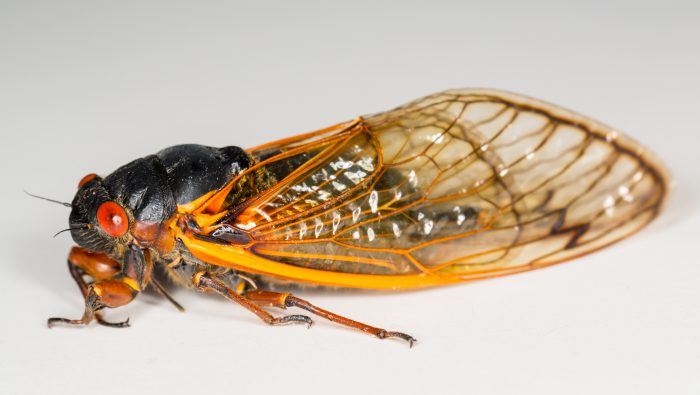Cicadas (say sih-KAY-dahs) are a type of insect well known for one thing: their "song." The call of a cicada can reach 100 decibels, which is as loud as a chainsaw or a lawnmower! That's pretty incredible as it is. But certain species of cicada—the magicicadas—can lay claim to something else quite special. They are one of the longest living insects in the world!
Despite the fact that you'll only see them for a few weeks every 17 years.
They came from underground!
Magicicada are also known as periodical cicadas. Even though they are so long-lived, they spend almost their entire life as nymphs, or youth, living underground. They live in burrows, feeding off the liquid found in tree roots.
"Won't need this anymore! A cicada next to a discarded nymphal case, or its former shell. (Getty Embed)
Then, after 17 (or in some cases 13) years have passed, an entire group of billions of these bugs dig up and emerge from the ground. They then spend a brief period molting (or shedding skin and changing) into adults, making a lot of racket, mating and laying eggs, and dying. The entire process lasts only four to six weeks. And suddenly, the cicadas are all gone again.
Brood dudes
Freshly-hatched adult cicadas can have shriveled-looking wings. This is because the wings haven't yet fully dried out. (Getty Embed)
Each of these groups of cicada are known as broods. There are seventeen broods in the United States. The latest one to emerge is called Brood VI (the Roman numeral for 6). This brood is just getting started right now, and is mainly found in parts of Georgia, North Carolina, and South Carolina, as well as Ohio and Wisconsin.
In the areas where this brood is active, the cicadas will appear to completely take over the area. The number of bugs can get up to 1 billion per square mile (2.58 square kilometres, which is a little smaller than Central Park in New York City). That is a lot of bugs! And while these swarms are loud and intense, these insects are harmless—they don't sting or bite. You could even call them... cuddly?
But it does makes you wonder... why so many bugs at once? And why does it take so long between emerging? And, of course: Why 17 years?
All-you-can-eat
"What do you mean you're full? I'm right here!" (Getty Embed)
Scientists can answer some of these questions.
Periodical cicadas have adapted to use something called predator satiation. To be "satiated" is to be so well fed that you couldn't eat another bite. When the cicada buffet arrives, animals from birds and wasps to frogs and squirrels feed on them. And a lot of cicadas are eaten. But because there are so many of these insects, their predators simply get too full! So as a group, the cicadas survive simply because there is no way to eat them all!
Also, by waiting this long period of time between emerging, cicadas stop predators from specializing in hunting them. Most of their predators, like birds or wasps, live shorter than 17 or even 13 years. So while they might live to be pleasantly surprised by one cicada bloom (yummy!), they'll never see two. And therefore, they never get used to hunting cicadas.
As for why 17 years? No one really knows. It's such an exact number, and yet scientists are baffled by it.
In the mean time, you don't need to wait 17 years to watch this 2013 video on these fascinating insects.
(It was made during Brood II's emergence that year in the northeastern U.S., but the facts are pretty much the same!)
 The periodical cicada has distinct red eyes, which set it apart from its yearly cousins. (© Steveheap | ID 31595976/Dreamstime)
The periodical cicada has distinct red eyes, which set it apart from its yearly cousins. (© Steveheap | ID 31595976/Dreamstime)









